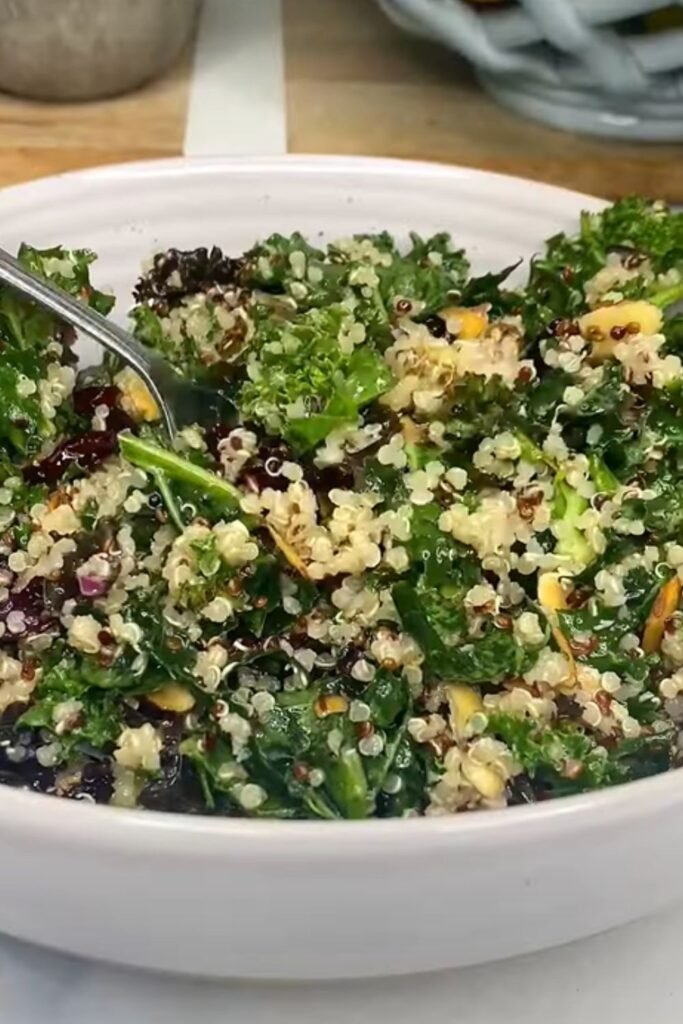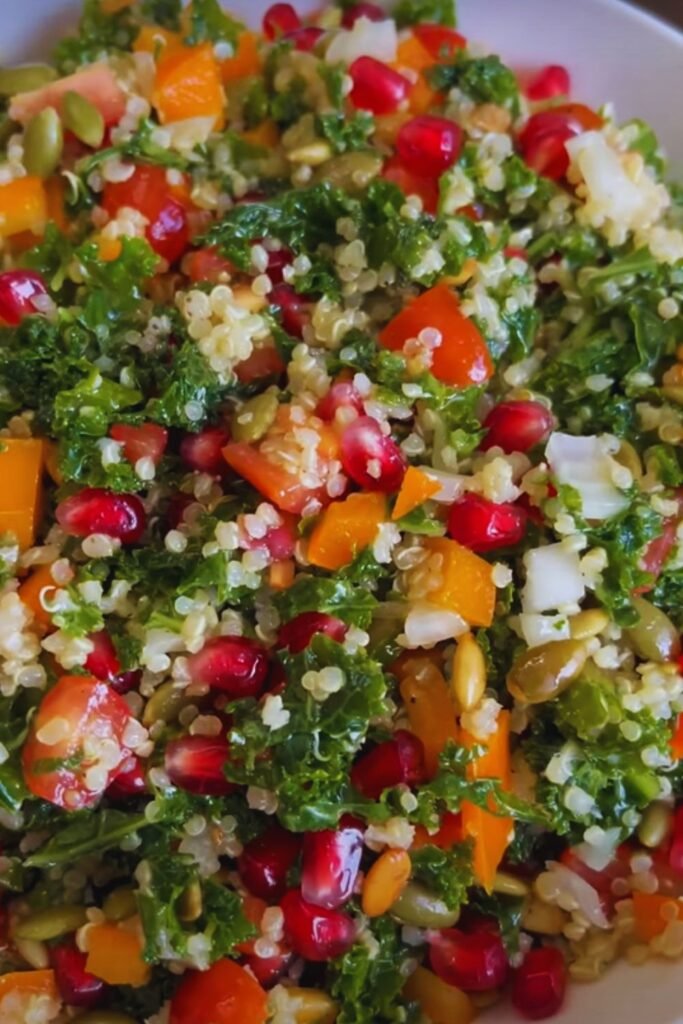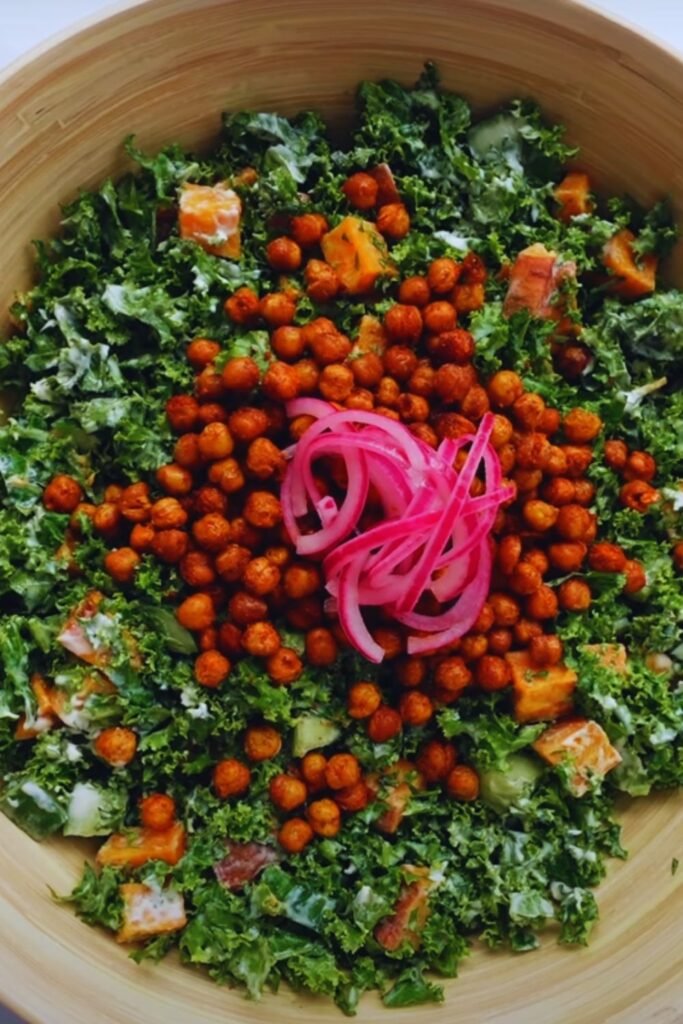When autumn arrives, I find myself craving hearty salads that combine nutrition with bold flavors. My Cranberry Kale Quinoa Salad has become my go-to recipe for potlucks, meal prep, and weeknight dinners. This isn’t just another boring salad – it’s a textural adventure packed with superfoods that will leave you feeling nourished and satisfied.
I’ve spent years perfecting this recipe, finding the perfect balance between earthy kale, nutty quinoa, tart cranberries, and a zingy lemon vinaigrette. What makes this salad special is its versatility – enjoy it as a standalone lunch, a dinner side dish, or even as a base for grilled chicken or roasted salmon.
The Power-Packed Ingredients
Before we dive into the recipe, let’s talk about why these ingredients make such a nutritional dream team:
Kale
: This leafy green powerhouse contains more vitamin C than an orange and more calcium than milk. I prefer lacinato (dinosaur) kale for its tender texture and slightly sweeter flavor compared to curly kale.
Quinoa
: A complete protein containing all nine essential amino acids, quinoa provides sustained energy and a delightful nutty flavor. It’s technically a seed, not a grain, making it suitable for many specialized diets.
Dried Cranberries
: These ruby gems offer a perfect sweet-tart contrast while providing antioxidants and vitamin C. I recommend looking for varieties with reduced sugar or naturally sweetened with apple juice.
Pumpkin Seeds
: Rich in magnesium, zinc, and healthy fats, these crunchy seeds add wonderful texture and a nutritional boost.
Fresh Herbs
: Mint and parsley brighten the entire dish and aid digestion. I grow mine in my kitchen windowsill for the freshest flavor year-round.
The Perfect Cranberry Kale Quinoa Salad Recipe
Ingredients
For the Salad Base:
- 1 bunch lacinato kale (about 8-10 large leaves), stems removed and finely chopped
- 1 cup quinoa, rinsed thoroughly
- 2 cups vegetable broth (or water)
- 1/2 cup dried cranberries
- 1/4 cup raw pumpkin seeds (pepitas)
- 1/3 cup red onion, finely diced
- 1/4 cup fresh mint leaves, chopped
- 1/4 cup fresh parsley, chopped
- 1/3 cup crumbled feta cheese (optional for non-vegan version)
For the Lemon Dijon Vinaigrette:
- 3 tablespoons extra virgin olive oil
- 2 tablespoons fresh lemon juice
- 1 tablespoon pure maple syrup
- 1 teaspoon Dijon mustard
- 1 small garlic clove, minced
- 1/4 teaspoon sea salt
- Freshly ground black pepper to taste
Instructions
- Cook the quinoa perfectly: In a medium saucepan, combine rinsed quinoa and vegetable broth. Bring to a boil, then reduce heat to low, cover, and simmer for 15 minutes until all liquid is absorbed. Remove from heat and let stand, covered, for 5 minutes. Fluff with a fork and spread on a baking sheet to cool completely.
- Prepare the kale: After removing the tough stems and chopping the kale, place it in a large bowl. Add a teaspoon of olive oil and a pinch of salt, then massage the kale with clean hands for 2-3 minutes. This crucial step breaks down the tough fibers, making the kale tender and more digestible.
- Make the vinaigrette: In a small bowl, whisk together olive oil, lemon juice, maple syrup, Dijon mustard, minced garlic, salt, and pepper until emulsified.
- Toast the pumpkin seeds: Heat a dry skillet over medium heat. Add pumpkin seeds and toast, stirring frequently, until they begin to pop and turn golden, about 3-4 minutes. Remove immediately to prevent burning.
- Assemble the salad: In your large bowl with the massaged kale, add the cooled quinoa, dried cranberries, toasted pumpkin seeds, diced red onion, chopped herbs, and crumbled feta if using. Drizzle with the vinaigrette and toss thoroughly to combine.
- Let flavors meld: For best results, let the salad rest for at least 30 minutes before serving to allow the flavors to develop fully.

Nutritional Profile
This salad isn’t just delicious – it’s a nutritional powerhouse. Here’s the breakdown per serving (approximately 1 cup):
| Nutrient | Amount | % Daily Value* |
|---|---|---|
| Calories | 285 | – |
| Protein | 9g | 18% |
| Carbohydrates | 37g | 12% |
| Dietary Fiber | 6g | 24% |
| Sugars | 9g | – |
| Fat | 12g | 18% |
| Saturated Fat | 2g | 10% |
| Vitamin A | 4125 IU | 83% |
| Vitamin C | 45mg | 75% |
| Calcium | 150mg | 15% |
| Iron | 3mg | 17% |
| Magnesium | 118mg | 28% |
| Potassium | 580mg | 16% |
*Based on a 2,000 calorie diet
Variations to Keep It Exciting
I never get bored with this salad because it’s so adaptable. Here are some of my favorite variations:
Seasonal Adaptations
| Season | Suggested Variations |
|---|---|
| Spring | Add fresh strawberries, swap mint for basil, add asparagus tips |
| Summer | Add blueberries and peaches, use lemon balm instead of mint |
| Fall | Add roasted butternut squash cubes and pomegranate seeds |
| Winter | Add roasted Brussels sprouts and blood orange segments |
Protein Additions
When I want to make this a more substantial meal, I add one of these protein options:
- Lemon-herb baked tofu cubes (vegan)
- Roasted chickpeas with smoked paprika (vegan)
- Grilled chicken breast with herbs
- Seared wild salmon
- Hard-boiled eggs
Grain Alternatives
While quinoa is my go-to, I sometimes substitute:
- Farro for a chewier texture
- Bulgur for a lighter option
- Wild rice blend for visual appeal
- Barley for a more substantial bite
Storage and Meal Prep Tips
This salad is perfect for meal prep! I often make a large batch on Sunday for lunches throughout the week. Here’s how I store it for maximum freshness:
- Base preparation: Combine the kale, quinoa, cranberries, and red onion in a large container.
- Keep certain elements separate: Store the vinaigrette, toasted pumpkin seeds, herbs, and feta (if using) in separate small containers.
- Assemble individual portions: Each morning, combine a portion of the base with a sprinkle of seeds, herbs, cheese, and a drizzle of dressing.
When properly stored in the refrigerator, the base mixture stays fresh for up to 5 days. The unbending kale actually improves with time as it continues to soften slightly in the refrigerator.

Serving Suggestions
I love serving this versatile salad in different ways:
- As a standalone lunch with a slice of artisan bread
- As a side dish with roasted salmon or grilled chicken
- In a wrap with hummus for a portable lunch
- As a base for a grain bowl topped with a soft-boiled egg
- Alongside roasted root vegetables for a complete plant-based meal
- In small portions as an appetizer before a dinner party
- Mixed with extra greens for a more traditional salad
For a complete meal, I might serve it with warm apple cider in fall, sparkling water with citrus in summer, or an herbal iced tea year-round.
Troubleshooting Common Issues
Even experienced cooks can run into challenges! Here are solutions to common problems:
Bitter Kale
If your kale tastes too bitter:
- Make sure you’re removing all the tough stems
- Massage it longer and more thoroughly with a bit more oil
- Add an extra drizzle of maple syrup to the dressing
- Try lacinato (dinosaur) kale which is naturally less bitter than curly varieties
Mushy Quinoa
For perfectly fluffy quinoa:
- Always rinse thoroughly before cooking to remove the bitter saponin coating
- Use a 1:2 ratio of quinoa to liquid
- Avoid stirring while it cooks
- Let it rest, covered, after cooking
Dry Salad
If your salad seems too dry:
- Make a little extra dressing to add just before serving
- Add diced avocado for creaminess
- Mix in a tablespoon of Greek yogurt for moisture

Health Benefits Deep Dive
This salad isn’t just delicious – it’s medicinal. Let me share the specific health benefits that make this my go-to recipe when I need a nutritional boost:
Kale’s Super Powers
Kale contains powerful compounds called glucosinolates that support detoxification processes in the body. It’s also rich in lutein and zeaxanthin, which protect eye health. The vitamin K content (over 600% of your daily needs in one serving!) supports bone health and proper blood clotting.
Quinoa’s Complete Package
As a complete protein source containing all nine essential amino acids, quinoa helps build and repair tissues. Its complex carbohydrates provide sustained energy without blood sugar spikes. The high fiber content (5g per cup) supports digestive health and keeps you feeling full longer.
Cranberry Benefits Beyond UTIs
While most people know cranberries for urinary tract health, they’re also packed with proanthocyanidins – powerful antioxidants that help prevent cellular damage. These compounds may help reduce inflammation and support heart health.
Seed Power
Pumpkin seeds are one of the best natural sources of magnesium, which is essential for muscle function, blood pressure regulation, and mental health. They also contain zinc, which supports immune function and skin health.
Frequently Asked Questions
I often get questions about this recipe from friends and family, so I’ve compiled the most common ones here:
Q: Can I make this salad ahead of time for a party?
Absolutely! In fact, this salad actually improves after sitting for a few hours as the flavors meld. I recommend adding the pumpkin seeds just before serving to maintain their crunch.
Q: Is this recipe gluten-free?
Yes, this salad is naturally gluten-free. Just be sure to check your ingredient labels, particularly the Dijon mustard, which occasionally contains trace gluten.
Q: My kids don’t like kale. Any substitutions?
Baby spinach makes a great kid-friendly alternative. You can skip the massaging step and just toss everything together. Another option is to finely chop the kale so it’s less noticeable.
Q: How can I make this salad vegan?
Simply omit the feta cheese or replace it with a vegan alternative. Some diced avocado can provide similar creaminess.
Q: Can I use fresh cranberries instead of dried?
Fresh cranberries are quite tart. If you’d like to use them, I recommend cooking them first with a bit of maple syrup to soften their tartness. Add about 1 cup fresh cranberries and 2 tablespoons maple syrup to a small saucepan and cook until they pop, about 5 minutes.
Q: What can I substitute for maple syrup in the dressing?
Honey works beautifully (for non-vegans). Agave nectar is another excellent option with a milder flavor profile.
Q: I don’t have red onion. What else can I use?
Shallots provide a milder onion flavor that works wonderfully. Green onions are another great alternative, adding color and a gentler bite.
Q: Can I use regular curly kale instead of lacinato?
Absolutely! Curly kale works perfectly fine, though it may require a slightly longer massage time to become tender.
A Personal Note
I first created this salad when I was trying to incorporate more superfoods into my diet without sacrificing flavor. After years of refinement, it’s become my signature dish – the one friends always request I bring to gatherings.
What I love most about this recipe is its resilience. Unlike delicate green salads that wilt within hours, this hearty creation stands up to time, actually improving as the flavors meld. It’s become my secret weapon for busy weeks, providing nourishment even when time is scarce.
If you’re new to kale or quinoa, this recipe offers an accessible introduction. The sweetness of the cranberries and the tanginess of the dressing balance kale’s earthiness perfectly. Even self-proclaimed “kale skeptics” have been converted after trying this combination!
Remember, cooking is about making a recipe your own. Feel free to adjust any element to suit your preferences – add more cranberries if you love sweetness, increase the garlic for extra zing, or experiment with different herbs from your garden. The beauty of cooking lies in these personal touches that transform a recipe into your signature dish.
I hope this salad brings as much joy and nourishment to your table as it has to mine!
Q&A Section
Q: How long will this salad keep in the refrigerator?
Unlike most dressed salads, this hearty combination can last 3-4 days refrigerated. The sturdy kale actually improves as it marinates in the dressing. Store in an airtight container for best results.
Q: Can I freeze portions of this salad for later?
I don’t recommend freezing the fully assembled salad as the textures will change significantly. However, you can freeze cooked quinoa in portions, which makes preparation much faster.
Q: What’s the best way to massage kale?
Add a teaspoon of olive oil and a pinch of salt to your chopped kale, then use your fingertips to scrunch and squeeze the leaves for 2-3 minutes. You’ll notice the kale turn darker green and reduce in volume as it becomes more tender.
Q: How can I tell when quinoa is properly cooked?
Perfectly cooked quinoa will display a little “tail” (the germ) that separates from the seed. The quinoa should be tender but still have a slight bite, and all liquid should be absorbed.
Q: Can this recipe be doubled for a large gathering?
Absolutely! This recipe scales beautifully for crowds. For very large gatherings, consider setting up a “salad bar” with the base and toppings separate so guests can customize their portions.
Q: Is this salad suitable for people with nut allergies?
The recipe as written contains no nuts, but always check your dried cranberry brand as some are processed in facilities with nuts. The pumpkin seeds can be omitted or replaced with sunflower seeds if there are seed allergy concerns.
Q: What’s the best type of feta to use in this salad?
I prefer sheep’s milk feta for its tangy flavor and crumbly texture. Block feta packed in brine has better flavor than pre-crumbled varieties. For a milder option, try French feta.
Q: Can I use a different vinegar in the dressing?
While lemon juice provides the perfect brightness, white wine vinegar or apple cider vinegar can work as substitutes. You might need to adjust the amount slightly as vinegars have different acidity levels than lemon juice.


